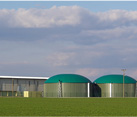|
 Biogas is defined as a gas produced by the anaerobic digestion or fermentation of indigenous organic matter under anaerobic conditions including but not limited to manure sewage sludge municipal solid waste and biodegradable waste originating from Malaysia. Biogas is defined as a gas produced by the anaerobic digestion or fermentation of indigenous organic matter under anaerobic conditions including but not limited to manure sewage sludge municipal solid waste and biodegradable waste originating from Malaysia.
Biogas technology refers to systems that designed to turn organic waste products into usable energy. Biogas typically consists mainly of methane, with a significant proportion of carbon dioxide, and smaller quantities of other gases such as nitrogen and hydrogen. The gases methane, hydrogen and carbon monoxide can be combusted. This energy release allows biogas to be used as a fuel in a gas engine to convert the energy in the gas into electricity and heat. Biogas is a renewable resources, so it qualifies for Feed in Tariff.
Biogas can be produced utilizing anaerobic digesters. A biogas plant can be fed with energy crops such as sludge municipal solid waste and biodegradable wastes. During the process, an air-tight tank transforms biomass waste into methane producing renewable energy that can be used for generated electricity.
Landfill gas is produced by wet organic waste decomposing under anaerobic conditions in a landfill. The waste is covered and mechanically compressed by the weight of the material that is deposited from above. This material prevents oxygen exposure thus allowing anaerobic microbes to thrive. This gas builds up and slowly released that can be used for heating, electricity, and many other operations that use any variation of an internal combustion engine.
By using biogas, many advantages arise. In future biogas could potentially help reduce global climate change. Normally, manure sewage sludge municipal solid waste and biodegradable waste that is left to decompose releases two main gases that cause global climate change such as nitrous dioxide and methane. Nitrous dioxide warms the atmosphere 310 times more than carbon dioxide and methane 21 times more than carbon dioxide. In addition, we can enjoy saving fossil fuels, protecting forests, enabling electricity production, and reducing air and water pollution.
|